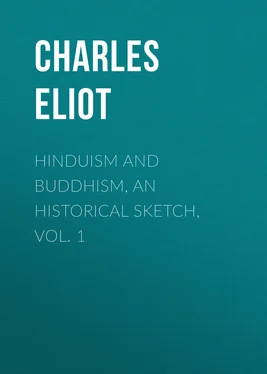Charles Eliot - Hinduism and Buddhism, An Historical Sketch, Vol. 1
Здесь есть возможность читать онлайн «Charles Eliot - Hinduism and Buddhism, An Historical Sketch, Vol. 1» — ознакомительный отрывок электронной книги совершенно бесплатно, а после прочтения отрывка купить полную версию. В некоторых случаях можно слушать аудио, скачать через торрент в формате fb2 и присутствует краткое содержание. Жанр: foreign_religion, Философия, Религиозная литература, foreign_psychology, foreign_antique, foreign_prose, на английском языке. Описание произведения, (предисловие) а так же отзывы посетителей доступны на портале библиотеки ЛибКат.
- Название:Hinduism and Buddhism, An Historical Sketch, Vol. 1
- Автор:
- Жанр:
- Год:неизвестен
- ISBN:нет данных
- Рейтинг книги:5 / 5. Голосов: 1
-
Избранное:Добавить в избранное
- Отзывы:
-
Ваша оценка:
- 100
- 1
- 2
- 3
- 4
- 5
Hinduism and Buddhism, An Historical Sketch, Vol. 1: краткое содержание, описание и аннотация
Предлагаем к чтению аннотацию, описание, краткое содержание или предисловие (зависит от того, что написал сам автор книги «Hinduism and Buddhism, An Historical Sketch, Vol. 1»). Если вы не нашли необходимую информацию о книге — напишите в комментариях, мы постараемся отыскать её.
Hinduism and Buddhism, An Historical Sketch, Vol. 1 — читать онлайн ознакомительный отрывок
Ниже представлен текст книги, разбитый по страницам. Система сохранения места последней прочитанной страницы, позволяет с удобством читать онлайн бесплатно книгу «Hinduism and Buddhism, An Historical Sketch, Vol. 1», без необходимости каждый раз заново искать на чём Вы остановились. Поставьте закладку, и сможете в любой момент перейти на страницу, на которой закончили чтение.
Интервал:
Закладка:
Sir Charles Eliot
Hinduism and Buddhism, An Historical Sketch, Vol. 1
BOOK I
INTRODUCTION
1. Influence of Indian Thought in Eastern Asia
Probably the first thought which will occur to the reader who is acquainted with the matters treated in this work will be that the subject is too large. A history of Hinduism or Buddhism or even of both within the frontiers of India may be a profitable though arduous task, but to attempt a historical sketch of the two faiths in their whole duration and extension over Eastern Asia is to choose a scene unsuited to any canvas which can be prepared at the present day. Not only is the breadth of the landscape enormous but in some places it is crowded with details which cannot be omitted while in others the principal features are hidden by a mist which obscures the unity and connection of the whole composition. No one can feel these difficulties more than I do myself or approach his work with more diffidence, yet I venture to think that wide surveys may sometimes be useful and are needed in the present state of oriental studies. For the reality of Indian influence in Asia—from Japan to the frontiers of Persia, from Manchuria to Java, from Burma to Mongolia—is undoubted and the influence is one. You cannot separate Hinduism from Buddhism, for without it Hinduism could not have assumed its medieval shape and some forms of Buddhism, such as Lamaism, countenance Brahmanic deities and ceremonies, while in Java and Camboja the two religions were avowedly combined and declared to be the same. Neither is it convenient to separate the fortunes of Buddhism and Hinduism outside India from their history within it, for although the importance of Buddhism depends largely on its foreign conquests, the forms which it assumed in its new territories can be understood only by reference to the religious condition of India at the periods when successive missions were despatched.
This book then is an attempt to give a sketch of Indian thought or Indian religion—for the two terms are nearly equivalent in extent—and of its history and influence in Asia. I will not say in the world, for that sounds too ambitious and really adds little to the more restricted phrase. For ideas, like empires and races, have their natural frontiers. Thus Europe may be said to be non-Mohammedan. Although the essential principles of Mohammedanism seem in harmony with European monotheism, yet it has been deliberately rejected by the continent and often repelled by force. Similarly in the regions west of India 1 1 The frontier seems to be about Long. 65° E.
, Indian religion is sporadic and exotic. I do not think that it had much influence on ancient Egypt, Babylon and Palestine or that it should be counted among the forces which shaped the character and teaching of Christ, though Christian monasticism and mysticism perhaps owed something to it. The debt of Manichaeism and various Gnostic sects is more certain and more considerable, but these communities have not endured and were regarded as heretical while they lasted. Among the Neoplatonists of Alexandria and the Sufis of Arabia and Persia many seem to have listened to the voice of Hindu mysticism but rather as individuals than as leaders of popular movements.
But in Eastern Asia the influence of India has been notable in extent, strength and duration. Scant justice is done to her position in the world by those histories which recount the exploits of her invaders and leave the impression that her own people were a feeble, dreamy folk, sundered from the rest of mankind by their sea and mountain frontiers. Such a picture takes no account of the intellectual conquests of the Hindus. Even their political conquests were not contemptible and were remarkable for the distance if not for the extent of the territory occupied. For there were Hindu kingdoms in Java and Camboja and settlements in Sumatra 2 2 See Coedes's views about Śrîvijaya in B.E.F.E.O. 1918, 6. The inscriptions of Rajendracola I (1012-1042 A.D.) show that Hindus in India were not wholly ignorant of Indian conquests abroad.
and even in Borneo, an island about as far from India as is Persia from Rome. But such military or commercial invasions are insignificant compared with the spread of Indian thought. The south-eastern region of Asia—both mainland and archipelago—owed its civilization almost entirely to India. In Ceylon, Burma, Siam, Camboja, Champa and Java, religion, art, the alphabet, literature, as well as whatever science and political organization existed, were the direct gift of Hindus, whether Brahmans or Buddhists, and much the same may be said of Tibet, whence the wilder Mongols took as much Indian civilization as they could stomach. In Java and other Malay countries this Indian culture has been superseded by Islam, yet even in Java the alphabet and to a large extent the customs of the people are still Indian.
In the countries mentioned Indian influence has been dominant until the present day, or at least until the advent of Islam. In another large area comprising China, Japan, Korea, and Annam it appears as a layer superimposed on Chinese culture, yet not a mere veneer. In these regions Chinese ethics, literature and art form the major part of intellectual life and have an outward and visible sign in the Chinese written characters which have not been ousted by an Indian alphabet 3 3 But the Japanese syllabaries were probably formed under Indian influence.
. But in all, especially in Japan, the influence of Buddhism has been profound and penetrating. None of these lands can be justly described as Buddhist in the same sense as Burma or Siam but Buddhism gave them a creed acceptable in different forms to superstitious, emotional and metaphysical minds: it provided subjects and models for art, especially for painting, and entered into popular life, thought and language.
But what are Hinduism and Buddhism? What do they teach about gods and men and the destinies of the soul? What ideals do they hold up and is their teaching of value or at least of interest for Europe? I will not at once answer these questions by general statements, because such names as Hinduism and Buddhism have different meanings in different countries and ages, but will rather begin by briefly reviewing the development of the two religions. I hope that the reader will forgive me if in doing so I repeat much that is to be found in the body of this work.
One general observation about India may be made at the outset. Here more than in any other country the national mind finds its favourite occupation and full expression in religion. This quality is geographical rather than racial, for it is possessed by Dravidians as much as by Aryans. From the Raja to the peasant most Hindus have an interest in theology and often a passion for it. Few works of art or literature are purely secular: the intellectual and aesthetic efforts of India, long, continuous and distinguished as they are, are monotonous inasmuch as they are almost all the expression of some religious phase. But the religion itself is extraordinarily full and varied. The love of discussion and speculation creates considerable variety in practice and almost unlimited variety in creed and theory. There are few dogmas known to the theologies of the world which are not held by some of India's multitudinous sects 4 4 Probably the Christian doctrine of the atonement or salvation by the death of a deity is an exception. I do not know of any Indian sect which holds a similar view. The obscure verse Rig Veda x. 13. 4 seems to hint at the self-sacrifice of a deity but the hymn about the sacrifice of Purusha (x. 90) has nothing to do with redemption or atonement.
and it is perhaps impossible to make a single general statement about Hinduism, to which some sects would not prove an exception. Any such statements in this book must be understood as referring merely to the great majority of Hindus.
Интервал:
Закладка:
Похожие книги на «Hinduism and Buddhism, An Historical Sketch, Vol. 1»
Представляем Вашему вниманию похожие книги на «Hinduism and Buddhism, An Historical Sketch, Vol. 1» списком для выбора. Мы отобрали схожую по названию и смыслу литературу в надежде предоставить читателям больше вариантов отыскать новые, интересные, ещё непрочитанные произведения.
Обсуждение, отзывы о книге «Hinduism and Buddhism, An Historical Sketch, Vol. 1» и просто собственные мнения читателей. Оставьте ваши комментарии, напишите, что Вы думаете о произведении, его смысле или главных героях. Укажите что конкретно понравилось, а что нет, и почему Вы так считаете.












